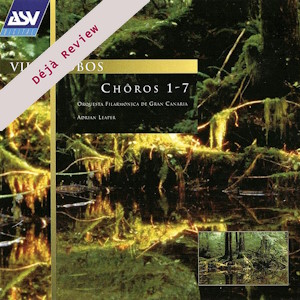
Déjà Review: this review was first published in September 2003 and the recording is still available.
Heitor Villa-Lobos (1887-1959)
Chôros 1-7 (1920-1929)
Carlos Oramas (guitar)
Johanne-Valérie Gélinas (flute)
Radovan Cavallin (clarinet)
Sergio Alonso (piano)
Coro de Filarmónica de Gran Canaria
Orquesta de Filarmónica de Gran Canaria/Adrian Leaper
rec. 2000/01, Sala Gabriel Rodó, Las Palmas de Gran Canaria, Spain
Presto CD
ASV CDDCA1150 [70]
The Bachianas Brasileiras stretch from 1930 to 1945 across nine numbered works. That series fused native Brasilian ambience with baroque style – specifically that of Bach. The Chôros (13 of them stretching from 1920 to 1929) chart the communion between Brazil’s popular music and the modern (read ‘Stravinskian’) tradition.
Do ASV plan a complete Chôros sequence, I wonder. The nine Bachianas Brasileiras are in an EMI 3CD set (recently deleted and available at an unmissable price from Berkshire Record Outlet) conducted by Enrique Batiz. It would be good if ASV one day offers all thirteen in a set.
The Introduction and the Chôros No. 1 both have a place for the classical guitar. In the First Chôros it is alone and centre-stage pensive and catchy – one of those classical guitar ‘hits’. The Introduction has a prominent place not only for the guitar but also for the saxophone – thus featuring two instruments much favoured by Villa-Lobos either as solos or as the focus for concertante works. Is it purely coincidental that these instruments also trace either their majority currency or their origins to bars, dance bands and popular use? The sax also appears in the Chôros No. 7.
I had never heard the Introduction before. It is a substantial melodic fantasia of a piece unashamedly dilute-echoing Ravel’s Bolero (5.43). The textures are kept clear so that the considerable song treasury of the piece is not suffocated. Succulent tunes are superbly matched with the sleepily pensive guitar (8.43). At 10.04 to 11.02 Villa-Lobos injects a triumphantly rhythmic and joy-brimming episode which soon evaporates as the guitar’s spell is re-cast in the humid shimmer. Villa-Lobos can blast the listener and souse the ears in suffocating density of instrumental strata. This can happen in The Forest of the Amazon (Dorian), the later Chôros (10 onwards) and in the symphonies. Here Villa-Lobos avoids the effect altogether.
The Second Chôros has the flute singing across the chatter of the clarinet. The Sixth Chôros Settimino is similarly inclined – even more Stravinskian with much of the rhythmic input owing tribute to The Rite of Spring. There is also a surprisingly Schoenbergian element (3.03). The manly fun of the Third Chôros makes much of the intricate clipping of the ‘pica-pau’ calypso ostinato just as much as the troika rhythm in Nightride and Sunrise or more appositely the folk-settings of Veljo Tormis. I wondered if the chorus could have sounded more primitive. Here they sound just a little too smooth. Lovely piece though.
The Fourth Chôros is the most ominous of the sequence – chugging, with some of the ceremonial feel of the wind music of the Gabrielis and later making way for a Broadway ‘blast’. After such ebullience the Fifth Chôros Alma Brasileira speaks at first of a spiritually absorbed Brazilian soul rather than the provocative carnival motley. Soon (3.03) a Gershwin-influenced emphasis arrives and then slips back into the dreamy warm waters of some upland lake. The contemplative strain can be linked with the prayerful warmth of the Introduction (tr.1).
The Sixth Chôros (for orchestra) is the longest piece here. It predates the Introduction by three years. It is the most immediately energetic of the Chôros here with sappy life proclaimed from the opening bars. It is the rhythmic counterpart to the poetic Introduction. Of the pieces here it is the most affected by the Matto Grosso. It has that restless and faintly threatening jungle atmosphere. Overall it is also the weakest and most miscellaneous of the Chôros although it has its moments as in the nostalgic neo-Elgarian nobilmente at 13.04 (reappearing with drizzling pomp at 23.02 to the end). This theme is later to be reused with more affecting simplicity in the Introduction (tr.1). The contented ‘high sierra’ tune at 17.11 is a jewel comparable with the singing melody at the crown of the finale of Ponce’s guitar concerto.
The violins of the Gran Canaria orchestra lack silkiness … but one adjusts. The brass and woodwind are outstanding and full of personable character.
A variegated collection then. The engineers adjust balance and microphone placement to cope with the wide range of demands from full tilt orchestal onslaught to intimate address.
ASV’s ‘branding’ remains delightfully distinctive in a market blessedly engorged with product. The label has with consistent success trod the line between gaudy brilliance and connoisseur taste. ASV’s discs stand out on the retailers’ shelves. Their designers should take a bow.
This is destined to be a prize-winning disc to be heard on many a veranda high above the sea … or close your eyes and conjure your own veranda.
Rob Barnett
Help us financially by purchasing from

Contents
Introduction to the Chôros for guitar and orchestra (1929)
Chôros No. 1 for guitar (1920)
Chôros No. 2 for flute and clarinet (1924)
Chôros No. 3 – Pica-Pau for male chorus and wind instruments (1925)
Chôros No. 4 for three horns and trombone (1926)
Chôros No. 5 – Alma Brasileira for piano (1925)
Chôros No. 6 for orchestra (1926)
Chôros No. 7 – Settimino for chamber ensemble (1920)


















